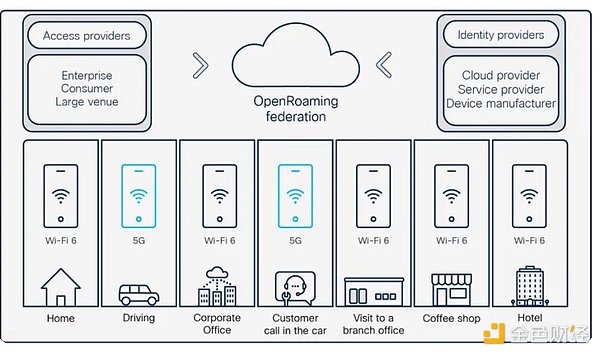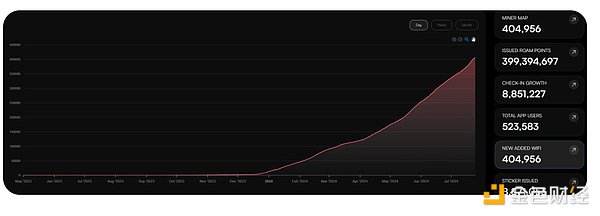Author: Riyue Xiaochu Source: X, @riyuexiaochu
In this bull market, DePIN is a must-participate track. Today we are studying a high-quality project that is not yet widely known, Roam.
It is a decentralized WiFi roaming network, and the number of global nodes has exceeded Helium Mobile.
For modern humans, air, water and the Internet are the three necessities of life. We hope that no matter where we go, we can easily access the Internet. Cellular networks (such as 4G, 5G) and WiFi have become the two major ways for users to access the Internet on a daily basis. When the cellular network cannot be used due to lack of signal coverage, poor indoor location, crowded people, etc., WiFi becomes the only life-saving medicine.
Roam aims to promote the construction of a decentralized global WiFi roaming network. Other DePIN projects are mainly decentralized platforms that aggregate physical devices, such as decentralized GPU computing power and decentralized broadband. Roam does not simply aggregate WiFi provided by users, but encourages users to build a global WiFi OpenRoaming™ roaming network with a Web3 token incentive mechanism. In the actual use of WiFi, we often encounter such troubles. In different places such as cafes, bookstores or airports, every time we go to a new place, we need to find a username and password, which is very troublesome. In addition, WiFi in public places also has security issues.
OpenRoaming™ is an initiative initiated by the Wireless Broadband Alliance (WBA) to establish a global WiFi network alliance. Promoters include Cisco, Google, AT&T, Boingo Wireless, Samsung, etc. In the OpenRoaming™ network, WiFi providers will abide by common standards and security protocols. More importantly, whenever a user goes to a place supported by OpenRoaming™, the device can automatically connect to WiFi without any operation. Connecting to Wi-Fi is as convenient as using a 4G/5G cellular network.
Such a good thing, in actual promotion, has been slow in overall progress due to the interests, education costs, hardware costs and other reasons. As the only Web3 project party among the 11 enterprise alliances of the WBA OpenRoaming™ plan, Roam not only established a Depin network that integrates OpenRoaming™, but also adopted token incentives to promote the development of the network faster.
The effect is significant. In the past 8 months, Roam's nodes have increased by 400,000, surpassing Helium Mobile to become the second largest DeWi network. At the same time, Roam users can also use more than 3.5 million WiFi nodes of OpenRoaming™. And Roam has a lot of room for growth. The scale of WiFi in the world is 700 million, and now less than 0.5% supports OpenRoaming™.
2 Roam Introduction
Roam aims to build a decentralized global WiFi OpenRoaming™ roaming network. By using decentralized identities (DIDs) and verifiable credentials (VCs), users can seamlessly connect to public WiFi networks. Eliminate the need for users to log in and register repeatedly. Roam uses advanced blockchain technology and economic incentive mechanisms to provide users and network providers with secure, efficient and convenient connection services.
Main advantages of Roam
Global WiFi roaming: Through Passpoint and OpenRoaming™ technology, Roam enables automatic roaming of devices between different WiFi networks, providing a seamless and secure connection experience. Users only need to register once to automatically connect to WiFi roaming networks that support OpenRoaming™ worldwide.
Decentralized identity authentication: Roam uses DIDs and VCs for secure network authentication to ensure user privacy and data security. Through zero-knowledge proof technology, users can authenticate their identities without revealing personal information.
Web3's token economic incentives:Roam uses a token incentive mechanism to reward users and network providers to promote the expansion and maintenance of the network. Users earn Roam tokens by adding WiFi hotspots, checking in at nodes, and participating in network activities.
Roam miners: Roam miners provide crypto mining capabilities and enterprise-level connection security. Users earn Roam tokens by deploying miners and enjoy stable network connections.
3 Passpoint and OpenRoaming™
First, let's introduce the core technologies used by Roam, Passpoint and OpenRoaming technologies.
Passpoint is a WiFi authentication and roaming technology developed by the Wi-Fi Alliance in 2012. It can simplify the process of users connecting to public WiFi networks while improving the security and reliability of connections. Passpoint allows devices to automatically discover and connect to Wi-Fi networks without user intervention (such as entering a password). Passpoint uses WPA2-Enterprise encryption and EAP (Extended Authentication Protocol) to provide a strong security authentication mechanism to ensure the secure transmission of user data.
Another function of Passpoint is to support seamless switching between WiFi networks. Devices can automatically switch between different WiFi networks without re-authentication. So, in simple terms, Passpoint technology allows devices (such as mobile phones and computers) to automatically connect without having to enter a password again when they move to another place.
Then, let's talk about OpenRoaming™, which is initiated by the Wireless Broadband Alliance (WBA) to establish a global network alliance. OpenRoaming™ provides smooth Wi-Fi access for mobile users by connecting access providers (such as public places, retailers, airports, and large enterprises) and identity providers (such as service provider operators, devices, and cloud providers).
The combination of Passpoint+OpenRoaming™ is equivalent to establishing a WiFi Alliance network composed of certified devices, and all WiFi here follow unified technical standards. Then, users can use this network to automatically authenticate and connect between different WiFi networks. Then, every time a user goes to a place supported by OpenRoaming™, the device will automatically connect to WiFi without any operation. Connecting to Wi-Fi is as convenient as using 4G/5G.

4 DID and VC
Decentralized identity (DID) is a new, verifiable, decentralized identifier used for identity authentication. Of course, this identity is broad, referring to any subject, such as individuals, organizations, and devices. Unlike the traditional centralized identity identification system, DID is controlled by the user himself: users can generate and manage DIDs by themselves, and store them in a distributed network, ensuring the security and immutability of DID data. Avoid the single point of failure and privacy leakage risks in traditional identity systems.
Verifiable credentials (VC) are standardized identity credentials format stored digitally on a computer or mobile device, similar to real-world documents. For example, if I am xiaochu, then I have a Tuanshuguan membership card, a driver's license, a university diploma, and so on. It enables more efficient and secure identity authentication. VC includes
Metadata: Contains the issuer information, validity period, credential ID, etc. of the credential.
Declaration data: Includes attribute information of the credential holder, such as name, age, qualifications, etc., and the issuer's certification of these information.
Cryptographic proof: A signature generated using an encryption algorithm to ensure the authenticity and integrity of the credential and prevent tampering and forgery
DID and VC form a decentralized identity credential. In the Roam network, DID and VC are widely used to implement secure authentication and privacy protection for OpenRoaming services. When a user accesses the Roam network, DID and VC are used for identity authentication. The user's DID and related VC are stored in the user's device, which can prove their identity and the validity of the credential without leaking sensitive information.
5 Token-incentivized DePIN network
Roam has built a DePIN ecosystem driven by the Web3 economic system. Based on the DePIN network, enterprises and individual users can join OpenRoaming™ through the Roam protocol according to their own circumstances. The simple way is to share hotspots by downloading Roam's mobile APP. Professional users can purchase Roam's Rainier MAX60 router.
1 In the APP
Users can download Roam's App, which supports Android and IOS. Roam App not only allows users to connect to the OpenRoaming™ WiFi network through the Roam app. For new users, downloading the app can get a one-time welcome reward, and social reward mechanisms such as sharing and invitations are set up to encourage users to spread socially. At the same time, Roam, which has hundreds of thousands of users, will also cooperate with other projects, and users can obtain airdrop rewards from other projects through various activities.

2 Roam routers
![]()
Then, it can be used as a Depin device for the Roam network to achieve automatic mining. Importantly, by running Rainier MAX60 and providing users with services such as OpenRoaming™ Wi-Fi, users can get four times the RoamPoints rewards of private Wi-Fi points.
Roam-baker-max30 will also be available in the future, priced at only $199.
The Roam router itself has excellent performance as a daily WiFi, and with continuous economic incentives, it will surely drive a large number of WiFi nodes to join the OpenRoaming™ network.

From the data, the number of Roam WiFi connections is growing rapidly. The number of WiFi connections has now reached 404,000. The number of APP users has reached 523,000. Roam's rapid growth began in December 2023, and in just 8 months, it has reached 400,000. In contrast, OpenRoaming has been under construction for many years, and the number of nodes is only more than 3.5 million now.
 JinseFinance
JinseFinance
 JinseFinance
JinseFinance JinseFinance
JinseFinance Edmund
Edmund JinseFinance
JinseFinance Others
Others Nulltx
Nulltx Bitcoinist
Bitcoinist Bitcoinist
Bitcoinist Bitcoinist
Bitcoinist Nulltx
Nulltx